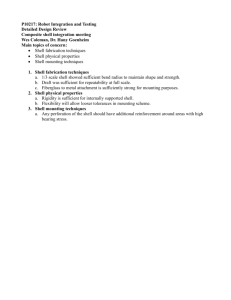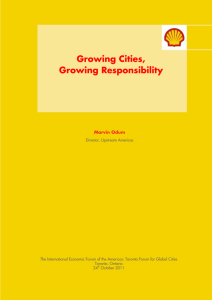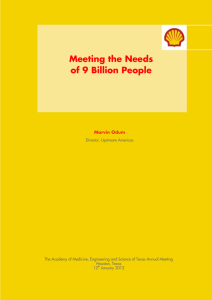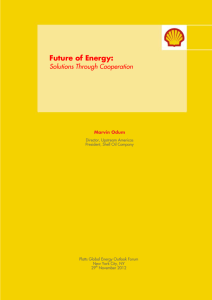Statement of Marvin E. Odum President, Shell Oil Company
advertisement
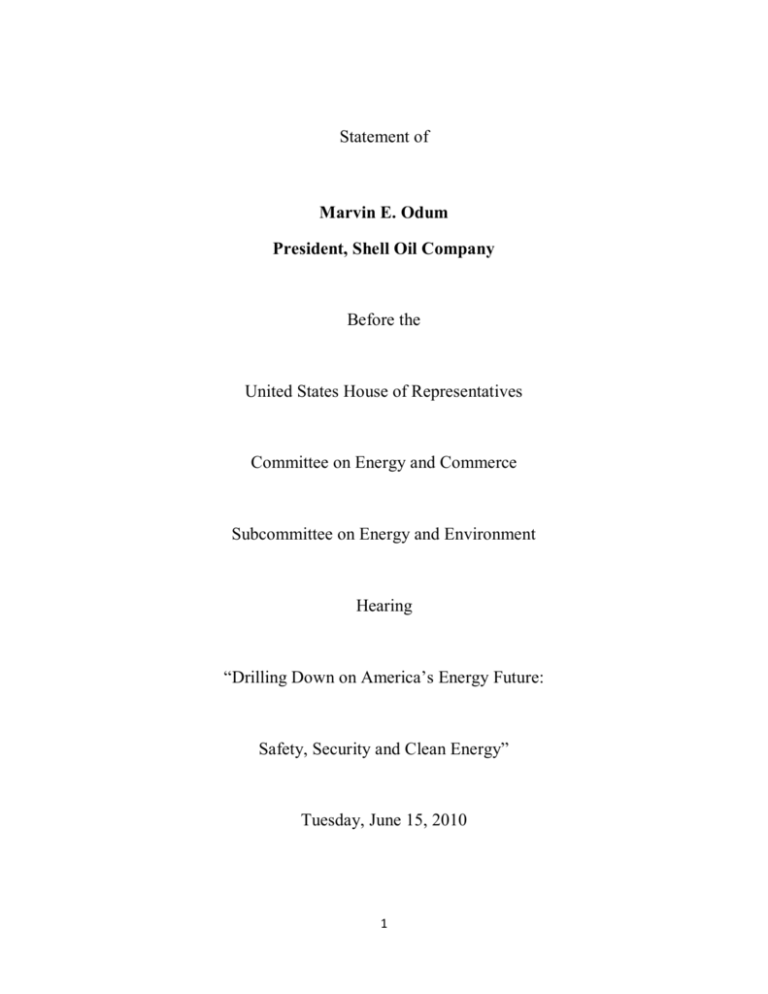
Statement of Marvin E. Odum President, Shell Oil Company Before the United States House of Representatives Committee on Energy and Commerce Subcommittee on Energy and Environment Hearing “Drilling Down on America’s Energy Future: Safety, Security and Clean Energy” Tuesday, June 15, 2010 1 Chairman Markey, Ranking Member Upton and members of the Committee: I am Marvin Odum, president, Shell Oil Company and I appreciate the opportunity to testify today. Before stating my comments on today’s topic, I’d like to briefly address the continuing situation in the Gulf of Mexico – which is on the minds of every American. All of us at Shell are deeply saddened by the Deepwater Horizon explosion and aftermath – a terrible tragedy for the families of those who lost their lives or were injured, as well as our neighbors in the Gulf region. Many of our employees and customers live along the Gulf Coast and feel the pain firsthand – in damage to our environment and our economy. Getting to the root cause of this incident is critical. Like you, we want to know what went wrong with this well and the execution of this well design. As investigation findings become available, Shell will incorporate learnings into our standards and operations. Shell is part of an industry task force working on recommendations to prevent such an incident from occurring again. We also are participating in the United States Coast Guard’s Deepwater Horizon Incident Specific Preparedness Review. Since the beginning, Shell has made experts and equipment available to BP and the responders, in addition to providing space for government and industry at 2 our Robert Training Center outside New Orleans. We immediately took steps to reinforce the safety of our operations with a comprehensive review of operating practices, testing frequencies and training protocols. We remain confident in our drilling expertise and procedures, built on a foundation of multiple required safety barriers, proven methods and strict company standards. The first imperative of any project is that it be done safely. Safety and environmental protection are, and always will be, Shell’s top priorities. In the context of this tragedy, we acknowledge the reasons for the President’s decision to pause deepwater drilling. But it is not without consequence: thousands of lost jobs, and billions in lost wages and spending. And not only on the Gulf Coast, but also in places like Alaska. This brings me to the topic you’ve asked us to speak about today -“America’s Energy Future.” I’ll begin with the long-term trends that guide our own business planning. Population and economic growth will drive global energy demand to double today’s use by 2050, even with strong efficiency gains. Energy supply from all sources – fossil, nuclear and renewable -- will struggle to keep up with this demand. 3 Environmental stresses will grow, making transition to lower-carbon economies even more urgent. With this as a backdrop, it’s clear the world needs a more sustainable energy system. Alternative and renewable energies could be 30% of the new energy mix by 2050, with cars powered by a variety of fuels such as gasoline, diesel, biofuels, natural gas, hybrids, electricity and hydrogen. However, fossil fuels will remain an important component of energy supply for decades to come. The scale and massive infrastructure of the global energy system means that change takes time. Our research shows that in the twentieth century, it took 30 years for new energy types to capture 1% of the market. But we can do better. We can accelerate that pace of change going forward. At Shell, we believe our industry can best contribute in three main ways: (1) making more energy available, (2) reducing emissions, and (3) increasing lowercarbon energy share while generating jobs -- and doing so safely and responsibly. Natural gas may not be a renewable, but it is abundant in the U.S. and a lower-CO2 energy source. It will be important both as a bridge to a low-carbon energy future and a vital “destination” in that energy mix. Increased natural gas use for electricity is by far the quickest and least expensive route to cleaner air. 4 Within a couple of years, Shell will be producing more gas than oil, much of that in North America. In the transportation sector, biofuels are the best hope for reducing transport CO2 for at least the next 20 years. Shell is the world’s largest supplier of renewable blend fuels, and we are investing in production of the lowest-CO2 biofuels – made from sugarcane ethanol. We estimate a CO2 reduction of anywhere between 70% and 90%, compared to conventional oil-based gasoline. A proposed $12 billion Shell joint venture in Brazil is expected to produce more than a half billion gallons of sustainable ethanol each year to start – with plans to grow and incorporate our advancing technology. Investments such as this, and in other technologies, are creating jobs. One out of every five dollars spent in the U.S. supporting green jobs comes from investments made by our industry, which already supports more than 9.2 million American jobs. We need to retain these good jobs and create new ones with new technologies – as America will need all the energy we can get to fuel the economy of the future. Society, government and business must all do their part to move to a lowercarbon economy. Absence of a robust energy policy has been a disadvantage to this nation. That is why Shell supports legislating a solution to energy and climate 5 issues as a means to create a secure U.S. energy future, reduce dependence on foreign oil and decrease greenhouse gas emissions. This requires setting a price for carbon, and we recommend cap and trade. The ability to respond to change is a hallmark of any successful business. Working with government, the oil and gas industry must make necessary improvements and adapt to a changing world. But shying away from development is not the answer. Offshore drilling is too important to U.S. energy supplies and our economy not to safely and responsibly move forward. Shell stands ready and able, with skilled people and state-of-the-art technology, to continue meeting America’s energy needs. I thank you for your time and I look forward to answering your questions. ### 6


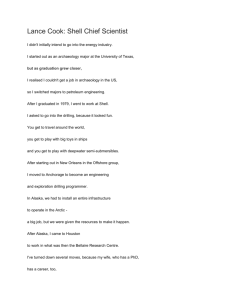


![[#IDENTITYCONNECTORS-299] SHELL scripting](http://s3.studylib.net/store/data/007586759_2-6776383e22ea2e271e255b7e6702f077-300x300.png)

